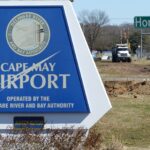STONE HARBOR — There was one sad lesson that the Jersey Shore learned during Superstorm Sandy: Shore towns and beaches can become easy victims for extreme flooding, causing damage to communities and sometimes causing nesting birds to lose the habitat they desperately need.
That is why New Jersey Audubon launched a program to create elevated habitat for beach nesting birds at Stone Harbor Point as well as a resiliency dune to help protect the community from floodwaters, in this era of unpredictable weather and climate.
Stone Harbor Point, an Atlantic coast barrier island in Cape May County, is situated at the southernmost end of Seven-Mile Island and designated as a “Protected Area” to be managed for threatened birds and their habitats. It provides a superb protective barrier to the Borough of Stone Harbor from damaging coastal storms and sea level rise.
Stone Harbor Point is also favored by residents and visitors for recreational activities, including fishing, bird watching, photography, walking, and jogging. It is an ever-changing coastal site that morphs in length, width, and height annually and is one of a few unimproved inlets along the New Jersey and mid‐Atlantic coastline.
The project, nearing completion, is supported through a $1.2 million grant from the National Fish and Wildlife Foundation’s Hurricane Sandy Coastal Resiliency Competitive Grant Program to restore and enhance beaches at Stone Harbor Point.
“Stone Harbor Point is a highly dynamic site that experiences changes in length, width and height on an annual basis,” explained Nellie Tsipoura, Ph.D., Senior Research Scientist & Director of Citizen Science for New Jersey Audubon. “Our project used a comprehensive restoration and management approach to improve habitat for wildlife and reduce vulnerability for the local community.”
Sand from re-nourishment activities north of the Point provides a continual resupply of sand to the area through southerly longshore drift. This ensures a long-term supply of sand for restoration.
Through local sand harvesting (ie. no dredging or trucking-in sand), New Jersey Audubon is building elevation and improving habitat quality for coastal birds, and reducing coastal flooding. Because materials are present locally, the cost for sand acquisition and transport are greatly reduced and sustainable, Tsipoura said.
Because plenty of sand is there, there’s no additional cost to buy and transport sand to the site, she said, adding there is also no need for dredging.
The project, which began in 2015, is a partnership with L. J. Niles and Associates, the Wetlands Institute, U.S. Fish and Wildlife Service, Conserve Wildlife Foundation, the New Jersey Division of Fish and Wildlife, Richard Stockton College of New Jersey Coastal Research Center, and the Borough of Stone Harbor to increase habitat for migratory and beach nesting birds, and coastal resiliency for the borough.
The project included two areas of elevated habitat that decrease flooding risks for nests of beach nesting birds and roosting habitat for shorebirds. It also created an elevated peninsula/island on the bay side, separated from Stone Harbor Point with a runnel. Finally, the project created a resiliency dune to protect the community from flooding from the south.
Additional restoration was needed in 2016 to repair damage from storms, especially Storm Jonas on Jan. 23-24, 2016, which brought high tides and wind-swept water to the Stone Harbor Point.
“Through monitoring, we are documenting any biological impacts of sand harvesting on intertidal invertebrate communities to determine if this method is an ecologically sound approach for protected wildlife areas,” Tsipoura explained. “We are also monitoring beach nesting birds, such as Piping Plover, American Oystercatcher, Least Terns, and Black Skimmer, to determine whether elevated habitats have resulted in decreased nest flooding and increased nesting and fledging success.”
New Jersey Audubon and partners are also monitoring use of the site by migratory shorebirds, including Red Knot, Semipalmated Sandpiper, Sanderling, Semipalmated Plover, Black-bellied Plover, Black Skimmers and Least Terns.
As part of the project, this partnership has conduced outreach to residents to hopefully eliminate any human disturbance at the site and implemented predator control to ensure improved nesting success.






